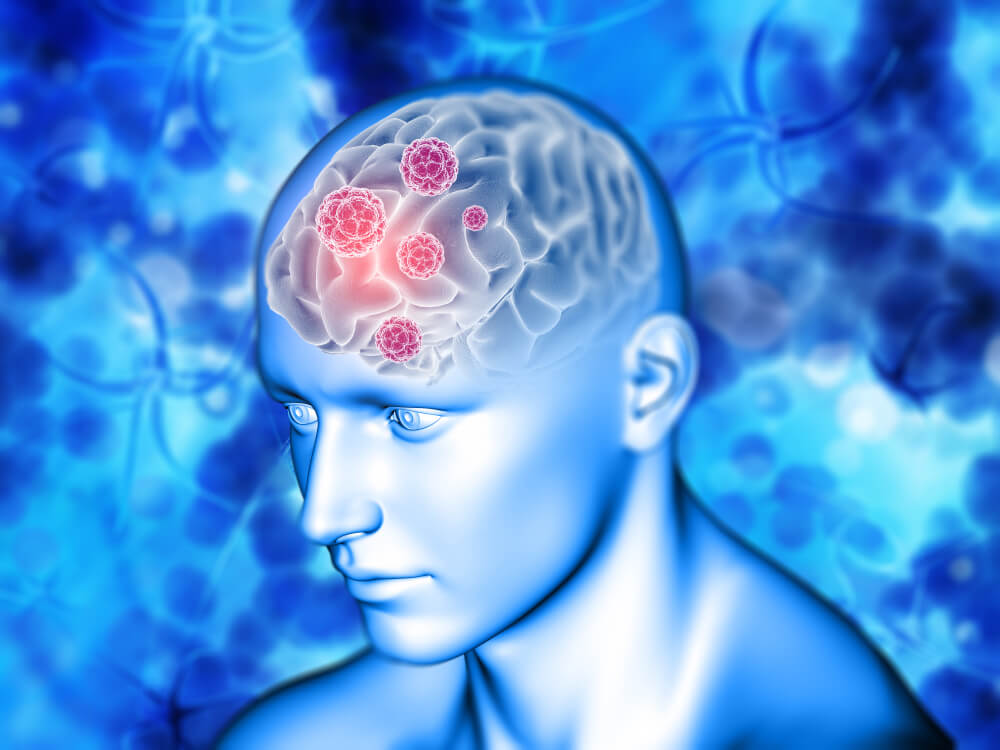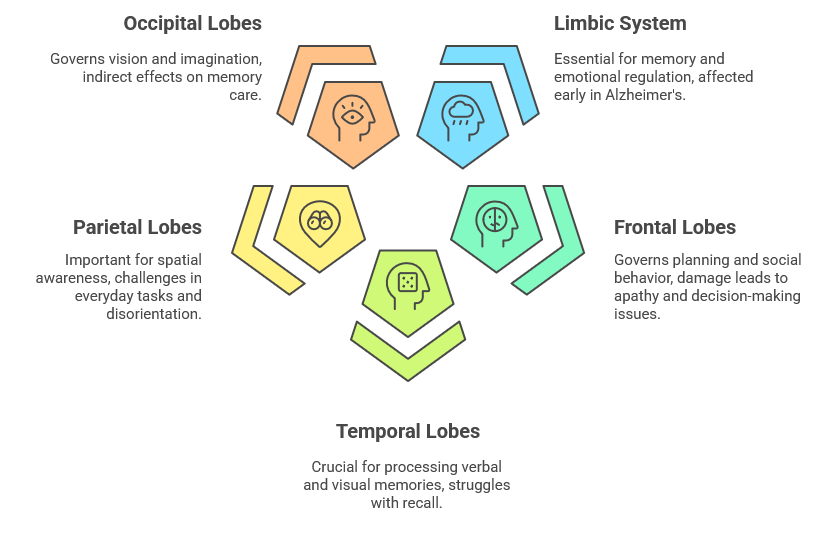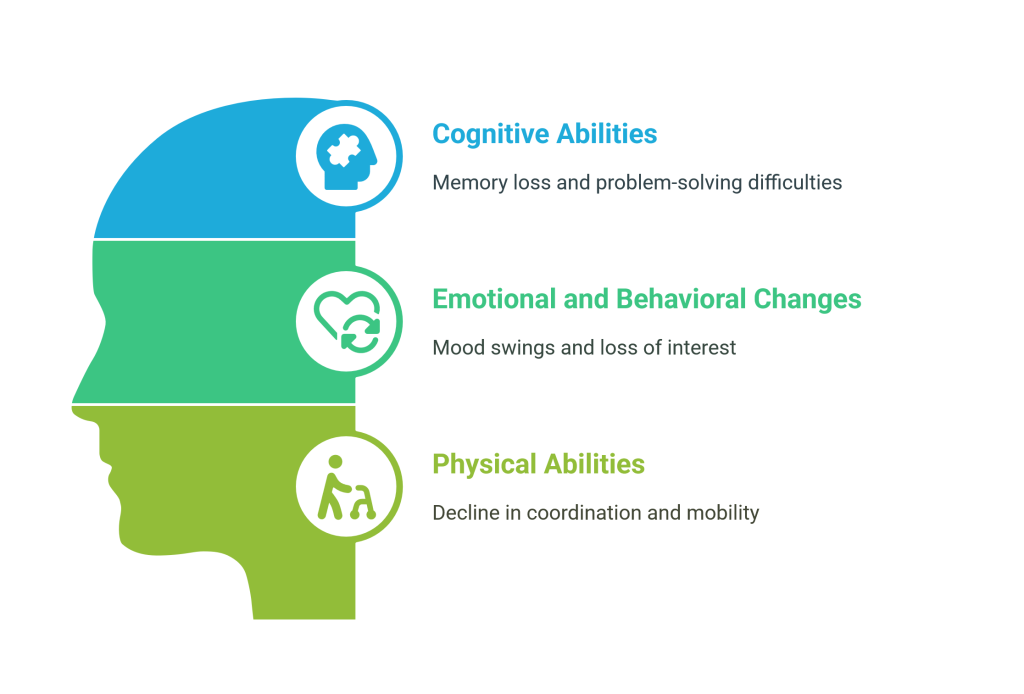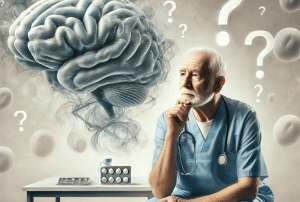The human brain is made up of billions of nerve cells called neurons. These cells send signals to each other, allowing the brain to control thoughts, movements, and emotions. They also connect the brain to the muscles and organs of the body. Alzheimer’s disease – is a memory loss disorder that causes damage to these cells, stopping them from working correctly. Over time, many of these cells die, leading to severe problems with memory, thinking, and daily activities.
Alzheimer’s is not just about memory loss—it affects how people think, behave, and interact with others. By learning which parts of the brain are affected and how this happens, we can better understand its signs and effects. In assisted senior living, recognizing these changes early can help provide the proper care and support. This article will explain what happens in the brain during Alzheimer’s, how it alters behavior and thinking, and why early understanding is crucial. Let’s explore this condition step by step.
Analyzing the Structure of the Brain
The brain comprises different parts, each responsible for specific functions. Its main building blocks are neurons, which are special cells that communicate in unique ways. Most neurons have three main parts:
- Cell Body: Contains the nucleus, which holds the mobile’s genetic statistics and regulates its activities.
- Dendrites: These department-like structures obtain signals from other neurons.
- Axon: This long, cable-like shape transmits messages to other neurons.
Neurons communicate through electric signals and neurotransmitters, permitting them to send and obtain messages. This intricate conversation network is crucial for cognitive features and ordinary brain fitness.
Key Processes Affected by Alzheimer
Alzheimer’s disease disrupts critical processes in the brain that are essential for its healthy functioning. This condition affects vital biological systems, leading to various symptoms, including behavioral changes associated with Alzheimer’s.
Communication
Neurons depend on clear communication to work correctly. When a neuron receives signals, it creates an electrical impulse that travels down its axon and releases neurotransmitters into the synapse, a tiny gap between neurons.
Metabolism
Metabolism refers to the biochemical processes by which cells convert nutrients, such as glucose, into energy. In Alzheimer’s disease, the brain receives less glucose, making it more difficult for neurons to obtain the energy they need. This energy deficit can lead to cell damage and failure over time, leading to various metabolism dysfunctions and disorders.
Repair and Regeneration
Neurons can adapt and repair themselves, but Alzheimer’s disease disrupts this process. The disease reduces neurogenesis, the creation of new neurons in key brain areas responsible for memory and learning. This impairs the brain’s capacity to heal and recover from damage.
Key Areas of the Brain Affected by Alzheimer’s
Alzheimer’s disease progressively impacts several vital areas of the brain, resulting in significant cognitive decline. The hippocampus, essential for memory and emotional regulation, is affected, as is the frontal lobe, which governs task organization and social behavior. Damage to the temporal lobes impairs memory retention, while injury to the parietal lobes disrupts spatial awareness.
Limbic System
The limbic system, particularly the hippocampus, is one of the first areas Alzheimer’s disease affects. This part of the brain plays a crucial role in memory formation and regulating emotional responses. In the early stages of the disease, symptoms often include difficulty remembering recent events, confusion, and mood swings.
Frontal Lobes
The frontal lobe plays a crucial role in planning, organizing, and regulating social behavior. Damage to this area can result in apathy, a loss of interest in activities, and difficulty making decisions. Affected individuals may also withdraw from social interactions or appear uninterested in things they once enjoyed.
Temporal Lobes
The temporal lobes, including the hippocampus, are crucial for processing verbal and visual memories. In Alzheimer’s, individuals may struggle to recall names, faces, or essential life information. This region is also involved in learning new information, making it more difficult for those with the disorder to retain what they learn.
Parietal Lobes
The parietal lobes play a crucial role in spatial attention and sequencing tasks. Damage to these areas can challenge everyday activities such as dressing or cooking. Additionally, individuals may struggle to recognize spatial relationships, resulting in disorientation.
Occipital Lobes
The occipital lobe primarily governs imagination and vision, but it can also be indirectly affected by Alzheimer’s disease. This impact may contribute to challenges in memory care and assisted living environments. Visual processing difficulties, such as trouble judging distances or recognizing motion, can emerge, making it more challenging for individuals to navigate their surroundings safely and independently.
Biological Changes in the Brain
Alzheimer’s disease causes significant changes in the brain. It leads to the accumulation of amyloid plaques between neurons, which disrupt normal cellular function. Additionally, abnormal tau proteins form tangles, further impairing neural communication. These changes contribute to the loss of neuronal connections, brain atrophy, chronic inflammation, and vascular issues, all exacerbating cognitive decline.
Amyloid Plaques
One of Alzheimer’s key capabilities is the formation of amyloid plaques. These are clumps of beta-amyloid protein that collect between neurons and disrupt mobile features. The presence of those plaques is related to the early tiers of cognitive decline.
Neurofibrillary Tangles
Neurofibrillary tangles are abnormal accumulations of tau protein within neurons, disrupting their transport system. In Alzheimer’s disease, tau detaches from microtubules and forms tangles, obstructing neuronal communication. Emerging evidence indicates that tau and beta-amyloid plaques contribute to brain changes in memory-related regions and spread as the disease progresses.
Loss of Neuronal Connections
As Alzheimer’s disease progresses, neurons begin to die, leading to a reduction in synaptic connections. This loss is particularly evident in brain areas responsible for memory and cognition, resulting in significant brain atrophy.
Chronic Inflammation
Research suggests that persistent infections within the brain may also contribute to Alzheimer’s disease. Normally, glial cells guide and protect neurons, but when malfunctioning, they can fail to clear harmful particles. This failure can lead to inflammation, further exacerbating neuronal damage.
Vascular Contributions
Alzheimer’s disease can also be influenced by vascular health. Conditions such as high blood pressure or diabetes can affect blood flow to the brain, exacerbating damage and increasing the risk of cognitive decline.
Symptoms and Changes Associated with Alzheimer’s
Alzheimer’s disease leads to cognitive, emotional, and physical changes. Individuals often experience significant memory loss, particularly for recent activities, along with difficulties in problem-solving and decision-making. Supporting brain health through diet is crucial during this time. A well-balanced nutrition plan can help manage symptoms and potentially slow cognitive decline. As the disease progresses, everyday tasks become increasingly challenging, often necessitating assistance.
Cognitive Abilities
Individuals may also experience significant memory loss, particularly regarding recent activities. They may struggle with problem-solving, decision-making, and following conversations. As the condition progresses, even long-term memories may be affected.
Emotional and Behavioral Changes
People with Alzheimer’s may experience changes in mood and behavior. They might become apathetic or lose interest in activities they once enjoyed, such as sports. Emotional responses can also shift, potentially leading to increased irritability or tension.
Physical Abilities
The disease can affect coordination and mobility. As their physical abilities decline, individuals may find it challenging to perform daily tasks such as dressing or bathing and may require assistance.
Let’s Recap
Alzheimer’s disease significantly impacts various areas of the brain, leading to challenges in thinking, emotions, and physical abilities. Understanding these effects in assisted senior living settings is crucial, as it allows caregivers and loved ones to offer better support. Ongoing research may also bring new treatments, helping individuals with Alzheimer’s live more fulfilling lives.
We at Shore Pines Senior Living are committed to offering the highest-quality care to residents experiencing memory loss. For over two decades, we have taken a person-centered approach, promoting independence, dignity, and overall well-being. Contact us today to learn more about our services and how we can support your loved ones!







